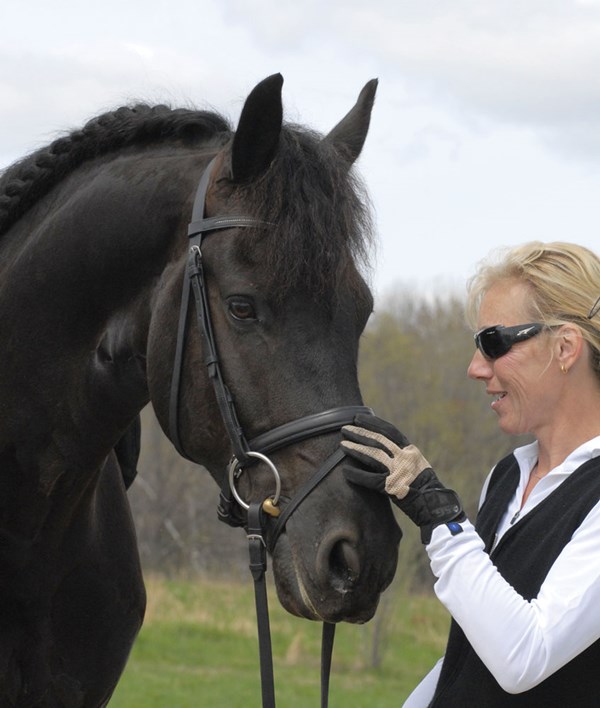Credit: Dusty Perin
The snaffle bridle is extremely useful for a horse’s true connection back to front and his lateral flexibility. If he is solid in his acceptance of the snaffle, he can compete in it in the national tests up to Grand Prix level.

Can I Use a Snaffle Bridle in FEI-Level Tests?
I’m planning on showing Prix St. Georges this year but would like to do it in a snaffle bit as my horse backs off the double bridle. Also, why should I use a double bridle when I have reached this level using a simple snaffle bit? What are your thoughts on riding at the FEI level using a snaffle bridle?
Becca Groff
Davidson, North Carolina
Barbi Breen-Gurley
First of all, congratulations on training your horse to the Prix St. Georges level. Many dressage horses don’t ever reach this level. Currently, in national competitions it is legal to compete at the FEI levels using a snaffle bit. Throughout the years, I have had some Grand Prix horses who preferred the snaffle bridle to the double bridle, and I am personally glad that this rule is in effect, as it can ease the transition to the higher levels. If your goal is only to compete in national tests—excluding CDI competitions, where the double bridle is required—there really is no need to push forward to find a solution to acceptance of a double bridle.
Through the numerous horses I’ve trained up through the different levels of dressage, I’ve grown to appreciate the individual strengths and weaknesses of each one. Some horses have the movement to die for, but maintaining soundness creates a challenge. Some horses learn extremely fast, but are too distracted by environmental changes. Some perform the upper-level movements easily, but fuss with a soft acceptance of the double bridle. Physical anatomy, previous experiences, trainability, character and innate sensitivity all have an effect on how each horse accepts new things. Some horses find a smooth connection to the snaffle or double bridle with confidence and ease. Others may find acceptance of even the snaffle bridle a challenge. We are fortunate that so many bit variations are available today, giving us many choices in our attempts to find the right bit for each horse. The height, width, shape and size of the port and shanks as well as harmony with the snaffle all play a part in each horse accepting the bit with comfort. If this is your horse’s “pea under the mattress,” and you want to find a solution, you’ll have to go through a lot of trial and error to find the right fit.
If your horse is solid in his acceptance of the snaffle bridle, the required collection and engagement, suppleness, power and adjustability can be daily improved through its use. This should be the bottom line upon which you present the exercises required at the Prix St. George level. The snaffle bridle is extremely useful for your horse’s true connection back to front and his lateral flexibility. And as previously stated, your horse can stay in the snaffle bridle and compete in the national tests up to Grand Prix level.
If your intention is to help your horse accept the double without resistance, you can gradually substitute the double bridle every few rides and try to attain the same quality of work. In your practice sessions, leave the curb rein looser and use a rubber or leather chain cover to soften the chain’s effect.
When introducing the double bridle, or if your horse is anxious about it, try using it on mellow trail rides. If your horse is reluctant to move out to it, have his teeth checked by an equine dentist, as sharp edges may be causing discomfort. The size of your horse’s mouth, the height of his palate and the height of his tongue all could be contributing to the bit not fitting the mouth properly.
Your goal really will determine which path to take. If your goal is to compete in international FEI-sanctioned shows, you must overcome your horse’s resistance to the double bridle. Even if competing in CDIs is not your goal, perhaps finding a solution to helping your horse accept the double bridle with confidence can be your goal outside of competition. At the end of the day, a happy horse is the reward we all seek, regardless of which path the rider chooses.
Barbi Breen-Gurley is a USDF “S” dressage judge and gold medalist. She has trained eight horses to Grand Prix and has been on the USEF long and short list several times during her career. She is currently showing her horse Vindicator in his first season at Grand Prix level. Together with her husband, Geof, she operates Sea Horse Ranch, a boarding and training facility in Los Osos, California.












